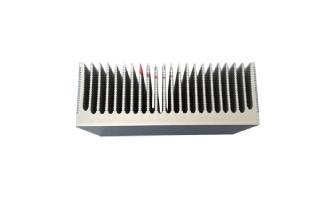Four: The heat dissipation design of the LED package is determined by the LED production process. The general flow diagram of the heat dissipation design of the LED package, which is mainly composed of the thermal design inside the chip and the thermal design of the package. In this way, through scientific and reasonable design, you can get satisfactory LED heat conduction and heat dissipation effect.
The packaging lens material is almost non-thermally conductive. Its role is to distribute and take out the light output of the chip. The heat of the chip is mainly exported by the internal heat sink and then dissipated by an external heat sink. Therefore, the primary heat dissipation design of the LED package is aimed at The requirements and conditions of use, through the scientific design of the internal heat sink, efficiently dissipate the high heat generated by the chip and conduct it to the heat sink.

Custom Led Heat Sink
Custom LED heat sink supplier china introduces you: For high-power LEDs that have been commercialized in China, the primary heat dissipation design constructed by the chip package is fixed and cannot be changed during use, so it is used as a light source When used in street lights, it is necessary to design a secondary heat dissipation scheme according to the actual working conditions and working conditions on site.
Six, LED secondary heat dissipation design process
The LED secondary heat dissipation design process is mainly expressed as: calculate the thermal resistance and junction temperature to see if it can meet the heat dissipation requirements of the LED. If the heat dissipation requirements can be met, the result will be directly output. Then see if the design can meet the heat dissipation requirements of the LED. If it can, you need to perform the next optimization design. If not, you need to redesign the heat sink until it can meet the requirements.
The internal heat sink of the LED transmits heat to the metal circuit board through the adhesive layer. The thermal resistance between the internal heat sink and the metal circuit board is Rc-b, and then the circuit board transmits the heat resistance to the heat sink through the adhesive layer, and the thermal resistance is Rb. -s, the radiator radiates heat into the air through the thermal resistance Rs-a.
(Tc-the temperature of the internal heat sink; Ts-the highest temperature of the radiator; Ta-the ambient temperature).
Factors affecting secondary heat dissipation
By analyzing the scheme and mechanism of LED secondary heat dissipation, it can be seen that the main factors affecting LED heat dissipation are:
(1) The role of the heat dissipation substrate is to connect with the internal heat sink of the LED to discharge and dissipate the heat. The common ones are:
Metal PCB circuit board-a technical method adopted in order to solve the problem of the circuit connection between the unit LEDs and the independence of the heat dissipation channels. The problems are large expansion coefficient, high specific gravity and heavy weight.
Common are metal low-temperature sintered ceramic substrates formed by combining ceramic and metal.
Metal-based composite material board-Metal-based composite material board is an improved type of metal PCB circuit board. Combining the high thermal conductivity of metal materials with the low expansion of reinforcing materials, it has the characteristics of adjustable expansion coefficient, small specific gravity, and high thermal conductivity.
(2) Uniform temperature board
Dissipate and dissipate the heat from the hot spots between the LED units to obtain a uniform temperature distribution on the heat dissipation surface, improve the heat dissipation effect, and benefit the overall heat dissipation of the custom led heat sink.
(3) There are 3 kinds of bonding materials commonly used in LED chips and heat sinks:
Thermally conductive adhesive-with a hardening temperature below 150 ° C, low thermal conductivity and poor thermal conductivity.
Electric silver paste—hardening temperature is lower than 200 ℃, it has good thermal conductivity and good bonding strength.
Solder paste-Compared with the above two types of adhesives, solder paste should be preferred because it has the best thermal conductivity and excellent electrical conductivity.
(4) Heat sinks There are many design schemes and forms of heat sinks, and they are mainly divided into two categories:
Passive cooling-The characteristic is that it does not need to consume additional energy (electricity) when dissipating heat, but the overall cooling capacity is limited, which is suitable for medium and low power LED street lights.
Active cooling-characterized by the need to consume additional power when dissipating heat, but the effect of heat dissipation is good, suitable for heat dissipation of high-power LED street lights.
(5) Improved thermal design In order to minimize the overall thermal resistance of the LED, that is, to reduce the amount of thermal resistance, some improvements have been proposed in the literature. They are summarized in the following two ways:
Thin film integrated packaging-eliminating the metal PCB board and directly generating the insulating film and the electrode film on the metal heat sink, the heat dissipation effect obtained by this is far superior to the conventional metal PCB board, which can further reduce the overall thermal resistance of the LED.
Direct chip packaging on the heat sink—cancel the conventional LED internal heat sink, and directly package the chip on a pre-designed metal heat dissipation surface with a special structure, and then perform overall packaging. This can also further reduce thermal resistance.